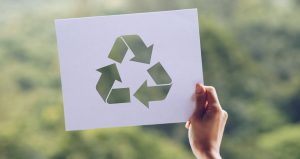
Paper and Cardboard Recycling
Each of us uses approximately one 100-foot-tall Douglas fir tree in paper and wood products per year. (EPA, 2008)
More than 56 percent of the paper consumed in the U.S. during 2007 was recovered for recycling — an all-time high. This impressive figure equals nearly 360 pounds of paper for each man, woman, and child in America. (Paper Industry Association Council, 2007)
More than 400 paper mills in the United States use at least some recovered materials in their manufacturing processes, and more than 200 of those mills use recovered fiber exclusively. (EPA, 2008)
Savings: Energy, Water, etc.
De-inked paper fiber is the most efficient source of fiber for the manufacturing of new paper products; one ton of de-inked pulp saves over 7000 gallons of water, 390 gallons of oil, and reduces air emissions by 60 lbs compared to traditional virgin fiber processes. (Abitibi Consolidated, 2005)
Recycling 1 ton of paper saves 17 mature trees, 7,000 gallons of water, 3 cubic yards of landfill space, 2 barrels of oil, and 4,100 kilowatt-hours of electricity — enough energy to power the average American home for five months. (EPA, 2008)
Recycling paper instead of making it from new material generates 74 percent less air pollution and uses 50 percent less water. (EPA, 2008)
Producing recycled paper requires about 60 percent of the energy used to make paper from virgin wood pulp. (EPA, 2008)
Uses of Recycled Paper
Just over 48% of office paper is recovered for recycling. This becomes raw material for paperboard, tissue, and printing and writing papers. (Keep America Beautiful, 2006)
Over 73% of all newspapers are recovered for recycling. Almost a third goes back into making more newsprint. The remainder is used to make paperboard, tissue, and insulation, or exported. (Keep America Beautiful, 2006)
Approximately 1.5 million tons of construction products are made each year from paper, including insulation, gypsum wallboard, roofing paper, flooring, padding and sound-absorbing materials. (American Forest and Paper Association, 2002)
Recycled paper can also be made into paper towels, notebook paper, envelopes, copy paper and other paper products, as well as boxes, hydro-mulch, molded packaging, compost, and even kitty litter. (EPA, 2008)
